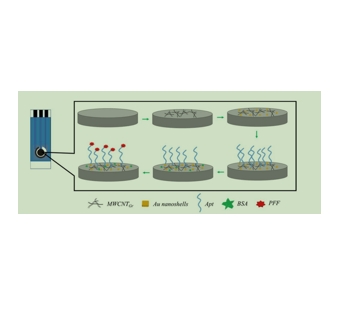文献:A Dual-Amplification Electrochemical Aptasensor for Profenofos Detection
文献链接:https://iopscience.iop.org/article/10.1149/1945-7111/ab6972
作者:Hui Zhang, Jianfei Sun, Shuting Cheng, Huimin Liu, Falan Li, Yemin Guo, and Xia Sun
相关产品:金纳米壳
原文摘要:The present study reported a dual-amplification electrochemical aptasensor for sensitive detection of profenofos (PFF) in vegetables. A screen-printed carbon electrode (SPCE) modified with graphitized multi-walled carbon nanotubes (MWCNTGr) and Au nanoshell was used as a test platform, which ensured a rapid detection process and showed a favorable electrochemical performance. MWCNTGr and Au nanoshell enhanced the electrical conductivity and the surface area, thus the detection signal was amplified. The affinity between PFF and its aptamer (Apt) was verified firstly by dot blot hybridization (DBH), and the result was exciting. Furthermore, the effects of the aptamers modified respectively with -NH2 and -SH on the current signal were compared with each other by cyclic voltammetry (CV), and results showed that the aptamers modified with -NH2 made the current signal change more obvious. Based on all above, a high-efficiency electrochemical aptasensor was fabricated with a wide linear range from 0.1–1 × 105 ng · ml −1 and a detection limit of 0.052 ng · ml −1 under the optimized conditions. This aptasensor had great specificity, stability and reproducibility. Hence, the developed aptasensor was successfully used to detect PFF in vegetables. The proposed method also has a potential for the detection of other organophosphorus pesticide (OPs). © 2020 The Author(s). Published on behalf of The Electrochemical Society by IOP Publishing Limited. This is an open access article distributed under the terms of the Creative Commons Attribution 4.0 License (CC BY, http://creativecommons.org/licenses/ by/4.0/), which permits unrestricted reuse of the work in any medium, provided the original work is properly cited.
Au纳米壳是指金材料形成薄层包覆在一个核心材料上,或者可能形成中空的结构。这种结构的金纳米壳展现出光学、化学和物理性质,使其在多种应用领域中非常有用。金纳米壳具有高度可调的光学吸收性质,即局域表面等离激元共振(LSPR)吸收峰可从可见光区迁移至近红外区域。

图为:适应传感器的制造程序。
Au纳米壳在补偿器制造中的应用:
在改性前,SPCE在硫酸溶液中以伏安循环进行循环制备,然后用超纯水彻底清洗并在氮气流下干燥。将 MWCNTGr溶液移到SPCE上,然后加入 Au纳米壳。改性后的SPCE可在室温下连续干燥。然后将 Apt溶液滴于改性的SPCE表面,孵育。这样就获得了用于PFF检测的适应传感器界面。当然,Apt 1和Apt 2分别制备的其他条件是相等的。然后,加入BSA,孵育,以避免非特异性吸附,阻断剩余的活性位点。制备的SPCE在低温下保存。为了测定PFF,将不同浓度的PFF溶液孵育到传感表面。

图为:MWCNTGr的 TEM(a)-(b);Au纳米壳的 TEM(c);MWCNTGr/Au纳米壳的原子力显微镜(d)。
结论:MWCNTGr由于其巨大的导电性和特殊的结构,可以更紧密地修饰SPCE。MWCNTGr与Au纳米壳结合可以有效提高自传感器的电活性。该传感器具有较高的特异性、重现性和稳定性,适应传感器在实际应用中具有测定OPs的潜力,该方法可应用于其他导电性好、易于修改、操作直接的传感器的制备。

 2024-12-18 作者:lkr 来源:
2024-12-18 作者:lkr 来源:

